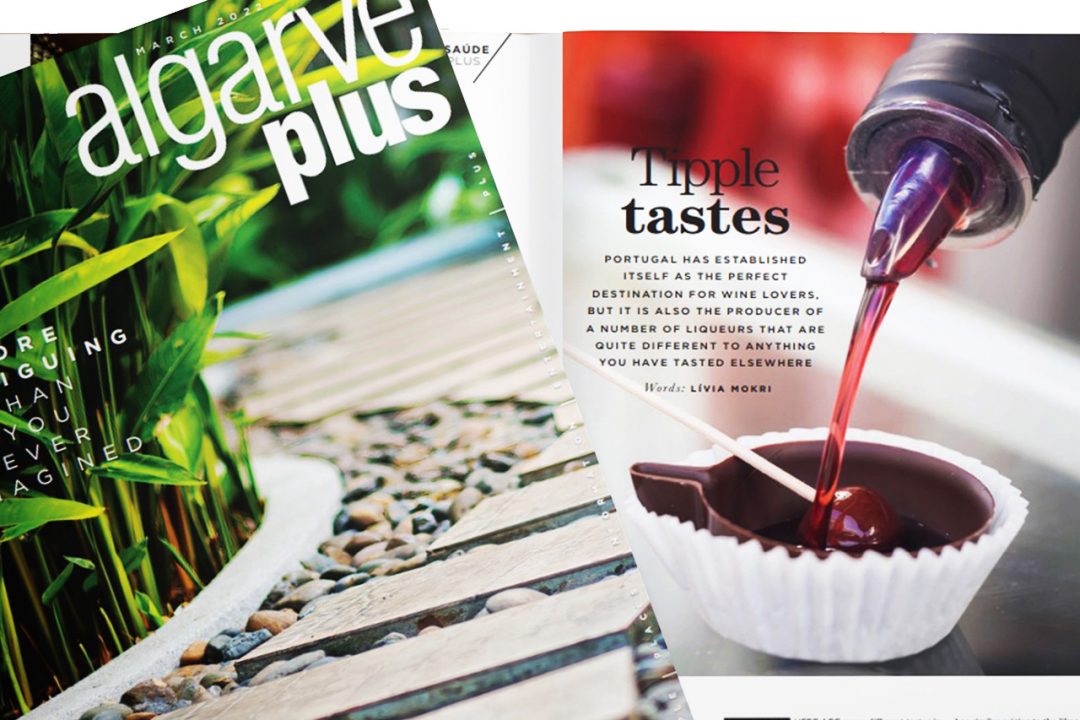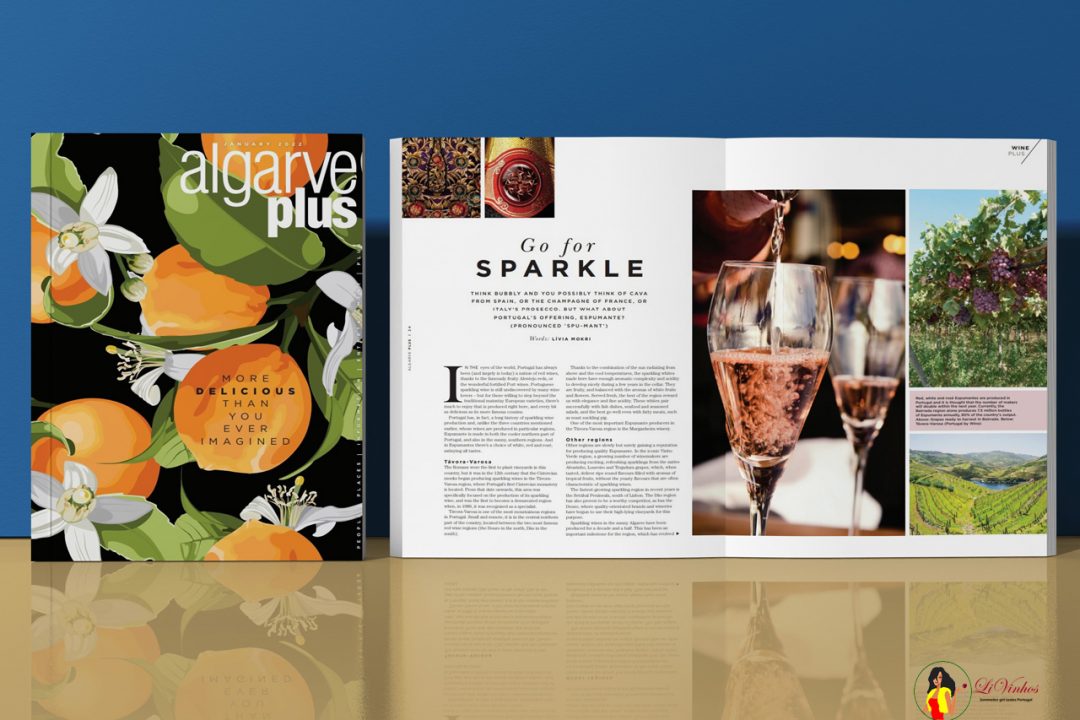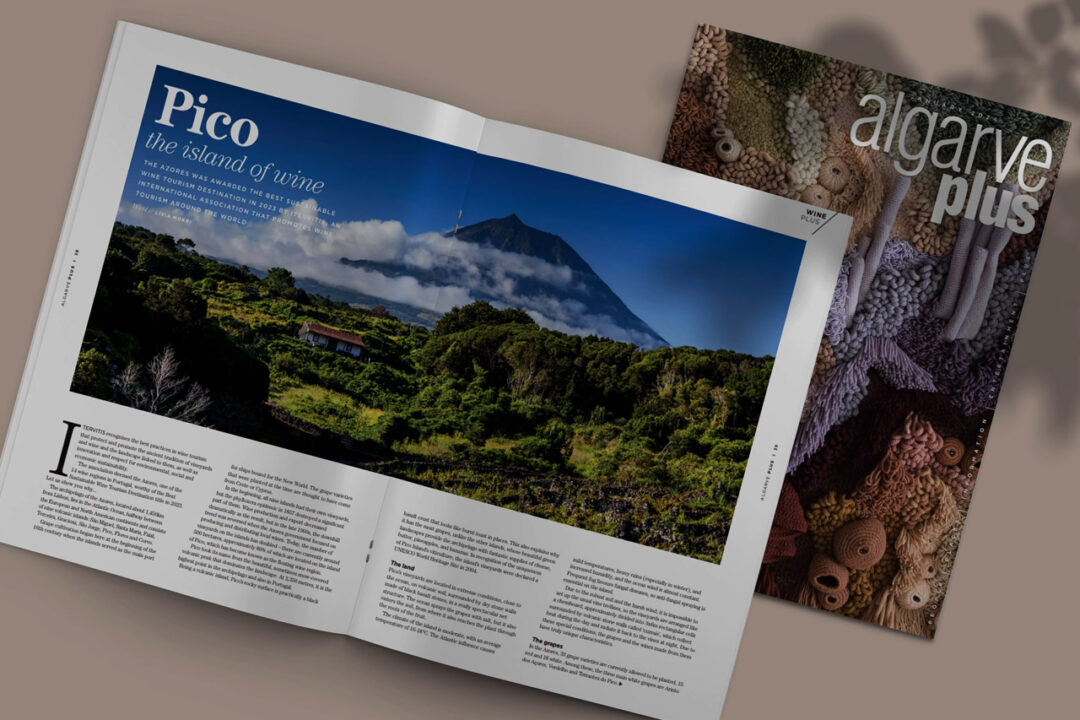Tipple tastes – There are many different tastes in the Portuguese liqueur repertoire and it is time to get to know them.
Portugal has established itself as the perfect destination for wine lovers, but it is also the producer of a number of liqueurs that are quite different from anything you have tasted elsewhere.
I am happy to share that the June issue of the Algarve Plus Magazine has already been published, with my new article!
The magazine is readable online or downloaded for free here.
Enjoy!
Or read here the whole article:
Tipple tastes
In the past years, Portugal has established itself as the perfect destination for wine lovers. The Portuguese wines and Ports are world-renowned but did you know that Portugal is also home to a wide selection of lesser-known, fascinating, unique liquors that don’t get much attention? Find out here which are the most popular!
LICOR BEIRÃO: PORTUGAL’S NATIONAL DRINK
‘O Licor de Portugal’ – this is the slogan that claims to be the national liquor. It’s pretty popular in Portugal where it can be drunk neat, in cocktails, in your coffee, and even in recipes for desserts and sweets.
It is a herbal liqueur flavored with multiple botanicals, herbs and spices. The exact recipe is still a family secret, but it’s known to include eucalyptus, cinnamon, rosemary, lavender, aniseed and mint. It has similar origins to the likes of the German Jägermeister, English Pimms, or the Hungarian Unicum.
HISTORY
The company of J. Carranca Redondo, Lda, the producer of Licor Beirão, was founded in 1940, but the history of the liqueur dates way back. The liqueur was already produced in Lousã before being named Beirão, in a pharmacy, for more than a century.
According to a widespread story, at the end of the 19th century, a Port Wine salesman, passing through Lousã, fell in love with the daughter of a pharmacist, and they ended up getting married. In the pharmacy, apart from the usual drugs, they sold “natural liqueurs” which were made with secret ancient formulas, as a medicinal product for stomach aches.
But meanwhile, a law forbidding the claim of medical properties for liqueurs came into force, so alcoholic beverages were no longer qualified as medicinal. The young man from the North took this opportunity and started producing the nectars independently, with the same craftsman’s processes, in a small factory.
And in 1929 the liqueur entered a contest on the 2nd Beirão Congress where it was awarded a gold medal, and it was then called Beirão.
But the problems caused by World War II caused the sale of the factory and the secret receipt, in 1940, to a young man from Lousã, José Carranca Redondo, who had worked there for some time. In his twenties he decided to invest his savings and bought the house and the secret, dedicating his body and soul to the liqueur that started to be produced with his wife.
From that moment on, sales started growing and it became a liqueur of great success. In the 1960s Redondo drove Beirão to nationwide success.
Until his death in 2005, when he was aged 89, José Carranca Redondo could be found in Quinta do Meiral on a daily basis and actively participated in the wide range of activities of the company.
Licor Beirão is currently still produced in Quinta do Meiral, in Lousã, with more than 12 hectares, where are produced some of the ingredients used in the liqueur’s secret recipe, the lavender and mint, for example. The remaining ingredients are brought from distant zones like India, Sri Lanka, Brazil, and Turkey, among others.
PRODUCTION
The usage of natural plants and herbs is one of this liqueur’s main distinctive factors. The liqueur is produced by double distillation of 13 different carefully selected aromatic seeds, herbs and spices, carried from all over the world.
After being weighed out and mixed in the correct proportion, the plants and herbs are mixed with a mixture of alcohol, sugar and water, and remain in maceration for a minimum of about twenty to twenty-five days. The water which is used to make Licor Beirão is the spring water from Serra da Lousã.
The resulting contents are then twice distilled in copper stills. These copper stills are a kind of material that does not impart any flavor to the alcohol, is acid-resistant and is a good heat conductor.
Then the Licor Beirão is filtered and stored in stainless steel vats for a few months during which time every ingredient is slowly releasing its characteristic properties and fragrances until it attains the ideal flavor., and is then nestled into thousands of bottles. The vats have a storage capacity of 25,000 to 100,000 liters.
Today, the average production capacity of the factory is 30,000 bottles a day. A decade ago the capacity was 10 times less!
The yellow ribbon embellishing the bottles of Licor Beirão (bottled in different sizes of 70 cl, 50 cl e 5 cl) is tied by hands. This means that each one of the millions of bottles scattered around the world has had at least one human touch!
This national brand today exports directly to 40 countries in the four corners of the world. Apart from Portugal, the region of the globe with the biggest per capita consumption of Licor Beirão is Switzerland.
TASTING NOTES
The drink has a pale amber color.
Sweet, alcoholic and herbal aromas with a hint of anise and thyme, on the nose. On the palate, it is a very smooth, soft and sweet liquor, having 22% alcohol content. It is like syrup, with notes of anise, orange and caramel.
Refreshing and delicious, especially with some ice cubes!
Licor Beirão is one of the most popular drinks in Portugal. It is usually consumed simply or with ice. Excellent digestive to taste after a wonderful dinner with friends, and also a good aperitif. And it is also used in cocktails or as an ingredient in desserts.
You’ll find a bottle of it in almost every pastry shop, café or bar. You can find Beirão filled chocolates, and even in some ice cream parlors, you’ll find homemade Licor Beirão ice cream.
Cocktails with Licor Beirão
The producers of Licor Beirão created two cocktails based on more popular drinks. The Brazilian caipirinha has been renamed the Caipirão, swapping Cachaça for Beirão in the process. Loaded with ice and lime, it’s a sweet and refreshing drink, that’s less strong than your typical caipirinha. The Morangão is a twist of the caipirão. This time swapping the limes for crushed strawberries or strawberry juice, and a dash of lemon juice.
As well you’ll find other popular drinks at bars and cafés with Beirão. One of the ones we see most often is a combination of limes, ginger ale and Beirão. Or lemon juice, tonic and Beirão. Including also their own version of an Irish coffee, served with a splash of Licor Beirão.
Just as the Portuguese know the difference between a liqueur and Licor Beirão, also the world acknowledges that Licor Beirão is not, in fact, merely a liqueur, but it is a special and unique drink, which has conquered not only the Portuguese but the rest of the world.
GINJA / GINJINHA
Ginja is a traditional Portuguese sour cherry liqueur that is mostly associated with Óbidos and Alcobaça, but it is enjoyed throughout the country, and it is also especially popular in Lisbon and Algarve. It is also called Ginjinha because the ’-inha’ is a diminutive in the Portuguese language.
The Ginja was born in the 17th century, but its creation was inspired by the ancient recipes of Cistercian monks, and only fresh, natural products should be used to produce it, with no artificial preservatives.
The liqueur is typically ruby red-colored, subtly sweet with strong cherry aromas. Its main ingredient is the Morello sour cherry, which is usually harvested in June, then added water and sugar and left for 5 months in fortified wine. This resulted in the birth of Ginja, a sweet cherry liqueur with a 16% of alcohol content. The Portuguese particularly love this liqueur and that is believed to be also a cure for many minor illnesses and cures. It is best served as an aperitif or a digestif, preferably neat.
It is said that the first Ginja Bar was opened in Lisbon in 1840 by a Galician named Espinheira, which became the Ginjinha Espinheira Bar. This bar is still located near Rossio Square and it still enjoys similar popularity not only for locals but also for tourists.
This tiny bar in Lisbon seats only up to 3-4 people and the walls are full of shelves filled with bottles of Ginja. Yes, with bottles… because you can not only taste this liqueur in the bar but even buy it to take with you home, maybe as a souvenir or a gift. And believe me, Ginjinha will be one of the most memorable Lisbon souvenirs for your friends or family members!
The drink is served in a small plastic cup and there are two ways to order: with some sour cherries soaked in liqueur or without them. Needless to say, it is worth tasting both!
After you get your cup in the bar, you can taste the drink right in the square, outside the bar, which is full of locals and tourists from morning till night who is wandering here not just to enjoy the flavor of this heavenly sweet cherry liqueur, but the place around the bar with the Rossio Square and the Church of St. Dominic is also real tourist sights.
Since the opening of the Espinheira Bar, several Ginjinha bars have been opened in and around Lisbon in the last decade, and even some bar owners have tried to make the drink more fashionable, so they use that also as a base for various cocktails.
Although the bars traditionally serve Ginja in a small glass or plastic cup, they become more common, especially in Patisseries, where the tasting is served in a small chocolate cup, so after you drink the liqueur, you can also eat the cup. Double pleasure, right?
I really recommend you taste this iconic cherry liqueur on your next trip to Lisbon, or you can join my Tavira tour in the Algarve when we visit a tapas bar and drink Ginjinha from a chocolate cup!
JEROPIGA
Jeropiga is a sweet liqueur wine in Portugal, that traditionally accompanies the autumn festivals, it is typically consumed on St.Martin’s Day with baked chestnut.
Its manufacturing process is similar to Port Wine or Moscatel – Jeropiga is prepared by adding brandy to the grape must to stop the fermentation, making it a sweeter and more alcoholic drink than wine. The addition is made at the beginning of the fermentation process. The usually given ratios of Jeropiga are two parts of must to one part of aguardiente or brandy. The must’s natural fermentation process is interrupted by the addition of alcohol.
The result is a brownish deep-gold-colored liqueur wine with floral and dried fruit aromas on the nose.
On the palate, it has a smooth texture with mixed citrus, orange peel and nutty flavors, sweetened with intense honey and raisin notes, with a persistent, sweet aftertaste. The aromas are balancing the sensations of freshness and sweetness.
A good combination of wood and wine. The alcohol content is 15,5%, due to the addition of brandy.
Historically, Jeropiga has been added to Port wine to increase its sweetness and is a practice that is still applied today to some fortified wines.
You should consume this liqueur wine at 16 °C of temperature before the meal as an aperitif, or fresh, slightly chilled for 10-12 °C to help digestive.
Typically pairing well with chestnuts on St. Martin days or ideal for any cakes, sweets, desserts, even with chocolate mousse.
A perfect drink to warm up the cold and long winter evenings.
And to help you, let’s see how you can prepare the baked chestnuts and a Jeropiga cocktail at home!
BAKED CHESTNUT RECIPE:
- Preheat the oven to 200º C.
- With a sharp knife, cut the chestnuts and soak them in water for 10 minutes.
- In an oven tray, arrange the chestnuts in a single layer, sprinkling them with 1 tablespoon of coarse salt.
- Place the chestnuts in the oven for 30 minutes or until the skins open.
JEROPIGA CITRUS COCKTAIL RECIPE:
Ingredients:
- 3cl Jeropiga
- 3 tablespoons of lemon juice
- Sparkling water
- Mint leaves to taste
- Crushed ice to taste
Put ice cubes in a cocktail glass to taste, then pour the weighed ingredients over it. Garnish with mint leaves.
LICOR ALFAROBBA – THE CAROB LIQUEUR
This liqueur is a sweetened and flavored drink made from carob, obtained through the technique of maceration of fruit for a specific period of time. After that period, the brandy is filtered and sugar syrup is added.
The carob tree or St. John´s bread tree is typical for the Algarve. In Portuguese, the tree is called Alfarrobeira and the fruit of this tree is called Alfarroba.
THE CAROB TREE
The carob tree is a member of the legume (pea) family, and is a flowering evergreen tree or shrub. It is a large tree and grows to 15m in 50 years. It is frost-tolerant to roughly −7 °C.
The tree flowers in September and October. Each carob tree is single-sex, so it takes a male and female tree to produce carob pods. A single male tree can pollinate up to 20 female trees. After six or seven years, a carob tree is able to produce pods. Once a female carob tree is fertilized, it produces hundreds of pounds of dark brown pods filled with brown pulp and tiny seeds. It takes a full year for the pods to develop and ripen.
A large tree can produce one ton of beans in one harvest. Contrary to the orange trees, carob trees do not need much water.
The harvest is often done by knocking the fruit down with a long stick and gathering them together with the help of laid-out nets.
Further processing separates the seeds from the pulp, this process is called kibbling and results in seeds and pieces of carob pods. The seeds have to be peeled which happens with acid or through roasting.
The carob is widely cultivated for its edible pods and as an ornamental tree in gardens and landscapes. The carob tree is native to the Mediterranean region and the Middle East.
CONSUMPTION
The carob seeds and also the pods are edible. The ground seeds are used as a substitute for cocoa and as food, the pods are commonly used as cattle feed. Carob powder is also used as a food stabilizer and as a darkening agent.
In the Algarve, carob powder is used in baking as an alternative to chocolate and is also known by the name cacao do Algarve, which is sometimes used to replace cocoa powder. Carob pods are naturally sweet, not bitter, and contain no caffeine. The Carob products will generally contain substantially less sugar than their chocolate counterparts.
While chocolates are toxic to some mammals, the carob also has no caffeine, so it is sometimes used to make chocolate-like treats for dogs.
If you’re lactose-intolerant or choose to be vegan, carob is also a great dairy-free alternative.
Carob is also in many skin care products and medications.
THE BENEFITS TO DRINK LIQUEUR ALFARROBA
Using it for health benefits goes back 4,000 years to ancient Greece.
Carob is rich in antioxidants, mainly polyphenols. In addition, it has few calories and is an excellent source of fiber and B vitamins, calcium and magnesium.
In addition to being used as a substitute for chocolate, carob can bring some health benefits, the main ones being:
- Improves gastrointestinal health
Due to the fact that it contains fiber and tannins, the carob helps to improve the functioning of the intestine, maintaining the health of the intestinal microbiota.
- Cholesterol control
Carob is rich in antioxidants, which help to lower the levels of bad cholesterol, and thus promote the prevention of cardiovascular diseases.
- Control of diabetes
Because it is rich in fiber, such as pectin, it is possible to reduce the amount of sugar circulating in the body, which also helps regulate blood sugar levels.
- Promotes bone health
Carob is rich in calcium and magnesium, which help to improve bone density, strengthen bones and teeth, for example, and prevent fractures and osteoporosis.
- Promotes weight loss
Carob has few calories, is rich in fiber, and has fat content, so when it is part of a healthy and balanced diet, it can increase the feeling of satiety, favoring weight loss.
- It can improve sleep quality
Because it does not contain caffeine and has a sweet taste, it can be consumed at night without interfering with sleep quality, in the case of people sensitive to caffeine.
- May have anticancer action
Being rich in antioxidants, carob could protect cells from damage caused by free radicals, in addition to exerting anti-inflammatory action, which could help prevent cancer. However, more studies are needed so that this effect of carob can be confirmed.
People who add carob to their diet have seen benefits like weight loss and decreased stomach issues.
The 19th-century British chemists sold carob pods to singers. Chewing on carob pods helped singers maintain healthy vocal cords and soothe and cleanse their throats.
SOME MORE INTERESTING THINGS
Since the seeds of the carob tree all weigh the same, they were used to weigh diamonds, silver and gold in the Middle East. The word “carat” refers to the official name of the carob tree: Ceratonia Siliqua. The system was eventually standardized, and one carat was fixed at 0.2 grams. In late Roman and early Byzantine times, the pure gold coin known as the solidus weighed 24-carat seeds (about 4.5 grams). As a result, the carat also became a measure of purity for gold. Thus 24-carat gold means 100% pure, 12-carat gold means the alloy contains 50% gold, etc.
And another interesting detail is that rumor says that alfarroba is one of the secret ingredients of Coca-Cola.
Ancient Greeks were the first to grow carob trees, which are now grown all over the world, from India to Australia. Portugal produces around 40.000 tons of alfarroba per year, most of which is exported. This is a 32 million euro business. Only Marokko produces more, but the Portuguese claim to have the best quality.
AGUARDENTE DE MEDRONHOS
And finally, let me show you a drink that is not exactly a liqueur but a traditional fruit brandy, and perhaps the most popular in the Algarve.
Portugal’s local firewater. The Portuguese name for it is ‘Aguardente de Medronhos’, fruit brandy, and is made from the fruit of the ‘strawberry tree’, scientific name Arbutus Unedo.
The tree’s fruits look like strawberries, hence the common name of ‘strawberry tree’, but in fact, they more resemble lychee, are spikey fruits, grow in bunches, and are ready for picking when are a rich orange/red color. It grows wild in the rocky soil, but in Portugal, it grows notably in the Alentejo and the Algarve. And this fruit is called medronho.
So, this Portuguese fruit brandy is distilled from fermented medronho berries, producing a brandy with a very high percentage of alcohol (averages at 50%) with a very strong and characteristic flavor.
Very few farmers have a license for distillation but are tolerated by the authorities to keep this traditional Portuguese specialty alive. Until recently, it was mainly found at the local taverns in Algarve, or bought mostly directly from the farmers, but the producers and the government have made an effort to turn medronho into an exquisite Portuguese product.
For many years, most families from Monchique for example made their own Medronho brand, and it was possible to visit some of the distillers to view the traditional equipment, and indeed, witness the distillation process itself.
All being well, picking fruits lasts until December, at which time they will start to concentrate on the task of distillation.
Fermentation starts with the fruit being poured into large pots or tanks. It is essential to keep the Medronho ‘mash’ humid otherwise it will turn bitter and the drink will fail miserably. This humidity is obtained by spraying the Medronho berries every day. As soon as there is a balance between the solid material and the liquid material the Medronho starts to bubble, meaning fermentation has begun and continues for 45 – 60 days.
The distillation process traditionally takes place in large copper tanks, which are heated up to allow the alcohol to be extracted. This process can last up to 7 hours and not all the resultant liquid will be bottled, only the part that guarantees the highest quality and has an alcohol concentration never lower than 42%.
The final product is a strong liquor, giving a burning sensation as it goes down your throat.
The drink is typically enjoyed neat, preferably as a digestif.
Just ask the locals! They’ll tell you it can heal everything from sore throats to stomach conditions. If you don’t fancy purchasing a whole bottle, many bars and cafés will offer you a tasting for a few euros.
But if you’re still not convinced, you can taste the Medronho fruit itself, which is high in antioxidants, or processed in jams and preserves. Your health will surely thrive!
And what about the taste? Well, nothing like strawberries! The fruit itself is an acquired taste, it is tart, and yes, edible, gritty and somewhat insipid, and it is said if you eat too many, you can get slightly drunk!
Aguardente de Medronho is both a very traditional and a typical drink in the south of Portugal.






No Comments Found